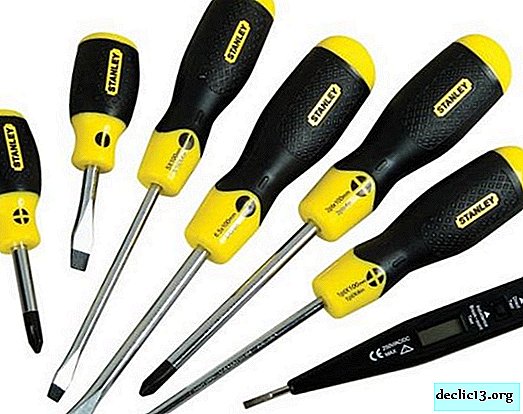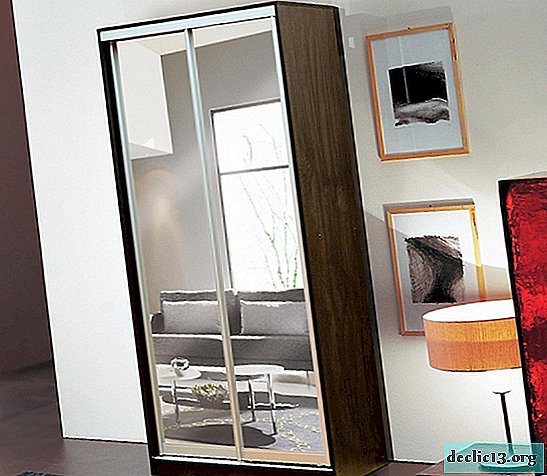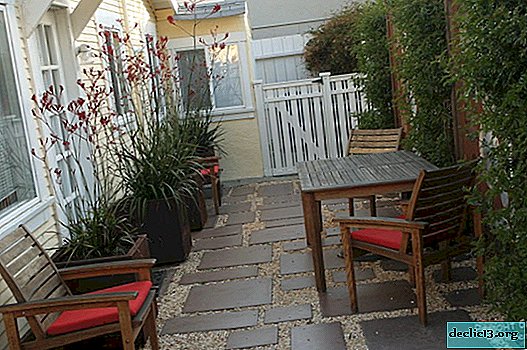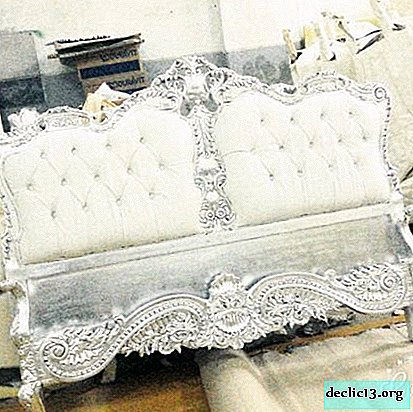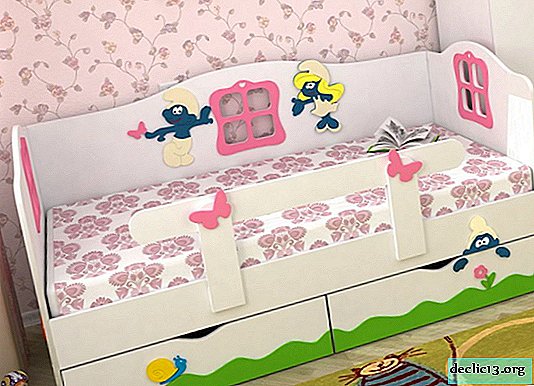What are the cabinets for a washing machine, the rules of choice
Oversized household appliances, compact furniture, a small area - the eternal problem faced by apartment owners. Traditionally, the layout of the living area provides for a small kitchen, bathroom or bathroom. Therefore, there are few options left to house the washing machine. To arrange household appliances compactly, beautifully and conveniently, you can use the cabinet for a built-in or stationary model washing machine. The product is made to individual sizes, which eliminates the complexity of using the unit and installation problems.
Appointment
Saving space is a decisive factor when choosing furniture for overall built-in appliances. A competent project, the original design of the cabinet model allows you to create the illusion of free space, as well as arrange products compactly, ergonomically. In most cases, washing machines are installed in the kitchen or in the bathroom, incorporating them in specially designated niches or modules. Such a cabinet helps to solve the following problems:
- space saving. The actual problem that almost all homeowners face is the compact installation of large-sized household units. Mounting the washing machine inside the cabinet frees up room space;
- aesthetic appeal of the work area. Regardless of which room the wardrobe (kitchen, bathroom) will be installed in, the room “wins” in aesthetics. Household appliances will not attract the attention of guests if you hide it behind beautiful furniture doors;
- rational use of free space. There are models of furniture for household appliances with additional sections, shelves, drawers. Internal filling depends on the size of the installation space. Inside, you can install baskets, nets, shelves for storing detergents;
- spectacular design of the room - furniture for rooms with high humidity can be made of moisture-resistant materials, the doors can be decorated with decorative facades, the product can be made in a suitable style so that all the furniture in the room looks like a single ensemble;
- maintaining order and ease of cleaning. A neat arrangement of equipment inside the cabinet simplifies the process of wet cleaning in the bathroom or in the kitchen. Housewives can stack various personal hygiene items, household cleaning products on shelves.
An additional plus of installing a washing machine in the interior of the cabinet is the soundproofing of working equipment. Typically, washing machines work loudly on spin options. The walls of the cabinet create some obstacle to noise and vibration, performing a sound-absorbing and sound-insulating function. The top panel of a small cabinet, built in under the sink, can be used as a convenient shelf for placing various accessories, small items, and hygiene products.
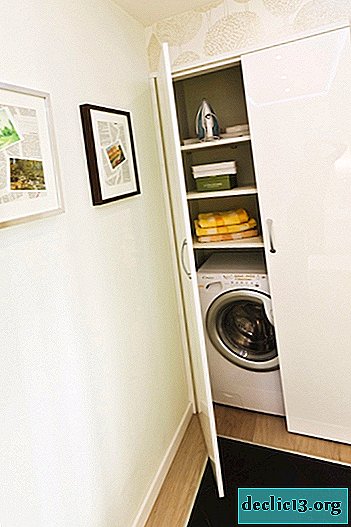




Kinds
The optimal solution for small rooms is a cabinet for a washing machine. If you make a successful project, you can find a place for the installation of internal shelves, cabinets, the symmetrical location of the dryer. The design of the furniture depends on the availability of space, the size of the washing machine. In modern housing, appliances are placed in the kitchen space, bathroom, hallway. These conditions determine the design features of models of cabinets, the choice of materials and decorative design, the execution of doors, if they are provided for in the design drawing.
According to the material of manufacture
To install a washing machine, you need to take into account the humidity of the room when choosing materials for the manufacture of furniture. Installation of equipment in the hallway allows you to implement any solution, but the bathroom needs moisture-resistant materials with a long service life. Another important point is the dimensions and weight of the machine. To install heavy models, it is necessary to use durable base materials, high-quality fittings, stable designs. Types of cabinets for washing machines according to the material of manufacture:
- MDF boards are a standard solution for the kitchen, hallway, but in the bathroom the furniture details at the joints are exposed to moisture and serve for a short time. A cabinet made of MDF can be given any shape, choose an interesting color scheme, use spectacular decor;
- natural wood treated with special moisture repellents. Wooden cabinets fit perfectly into the interior, are distinguished by a noble shade, ecological purity of natural material. Natural wood furniture is stable and durable, but does not tolerate moisture;
- glass combined with metal is an interesting solution for the installation of built-in units. The washing machine behind the glass doors looks unusual, neat, expensive. Modern glass processing technologies give the material extra strength, hardening, texture, matte, satin effect;
- a plastic cabinet is a ready-made option. Such models are not uncommon in homes and apartments due to their low cost of products. Plastic is not destroyed by moisture, mold and fungus do not appear on it. You can choose a cabinet for a washing machine of any color. A significant minus of plastic furniture is the fragility;
- furniture panel - an unusual, but justified option for installing a washing machine in the kitchen or in the hallway. Furniture panel - a natural material made from oak, beech, ash, birch wood. The tree is spread on small planks, which are glued securely. The shield is durable, durable, beautiful.
Cabinet materials for built-in appliances must meet the operating conditions of the furniture. Moisture-resistant materials are suitable for humid rooms; in rooms with normal humidity and stable temperature conditions, furniture from any materials can be installed. Of great importance is the functional content, equipment, installation location.
 Wooden
Wooden MDF
MDF Glass
Glass Chipboard
ChipboardBy location
In the apartment, house, in the country there are not many places where you can install a cabinet for a washing machine. Of course, at the whim of the homeowner, the equipment can even be placed in the living room, but such a decision is irrational, aesthetically unattractive and impractical. For the installation of dimensional equipment, you need to choose the right furniture, install the product in the most convenient place. There are only four acceptable options for installing washing machines in a cupboard - a bathroom, kitchen, hallway, toilet (extremely rare). In addition, furniture can be positioned in different ways on a free area:
- hinged option - the cabinet does not touch the legs of the floor, has a countertop under which they put the washing machine. On one side of the furniture structure, drawers or shelves are provided. There are no doors; the model is suitable for mounting front-loading machines. Furniture is hardly a full-fledged cabinet, but the solution is often implemented in narrow bathtubs, combining appliances, sinks, shelves. Another option is to mount on the wall an oversized washing machine with a small load;
- a floor cabinet is the most common way to integrate household appliances. Free-standing design allows you to hide communications, a washing machine, and above it to place hinged shelves, racks, other furniture products. Suitable for a complete set of bathrooms, kitchens, corridors. If the room allows you to install doors, the unit will not dust and become dirty. A small cabinet is sometimes called a washbasin cabinet due to the compact size of the product;
- high cabinet column (pencil case) built-in or stationary type. The model is located in a narrow space of the bathroom, kitchen, less often the hallway. The lower part of the furniture is used to install a washing machine, on which the dryer is mounted. On the mezzanine level there are shelves for storing household chemicals, bath textiles, cosmetic accessories and other necessary items. The upper module can be equipped with swing type doors;
- module or niche of a kitchen set. Permitted options for stationary installation of furniture, full or partial integration. When fully integrated, the machine can be hidden behind the front doors, giving the room a more neat appearance, the effect of a spacious room. There is a large selection of built-in appliances - an end face of a kitchen unit, a bar counter, if the machine is top-loading, a module with closed doors. With partial embedding, the equipment is placed under the countertop in a free niche.
In a narrow hallway, you can mount a built-in wardrobe across the width of the room, place a washing machine in the lower part, and use the upper tier for mounting mirrors with lamps, shelves, mezzanines for accessories. By the location of the cabinets for washing machines, they are conventionally classified into floor, wall, columns (pencil cases), cabinets, and by the method of installation - stand-alone models of a stationary type, furniture for full or partial integration.
 Column
Column Floor
Floor Modular
ModularBy design
The design of cabinets for built-in appliances is determined by the size of the furniture and the installation location. At the same time, the aesthetics of the model should correspond to the general style and design of the room. Ready-made furniture for washing machines can be conveniently located only in large rooms. In projects of individual sizes, you can implement a variety of design ideas. Most popular cabinet design solutions:
- angular design - two cabinet sides adjoin to adjacent walls of the room, two more serve as front panels. One front panel can be equipped with doors, and the second left open to accommodate the washing machine and shelves;
- direct built-in wardrobe from floor to ceiling with two to three sections. In the lower left or right corner leave an open niche for installing the washing machine. The model fits compactly in the hallway;
- A narrow cabinet for installation in a bathroom with a superstructure. The lower part of the furniture contains a washing machine, closed by doors; in the upper superstructure there is a mirror cabinet with shallow shelves for small items;
- vertical case for installation of equipment with a front loading drum. Furniture belongs to the classic stand-alone stationary type products. By the presence of free space, the product is equipped with one or two wings;
- the horizontal floor option in most cases is installed along the length of the free wall, combining with the sink, functional shelves. The machine can be closed with doors or located in an open niche.
When choosing a cabinet design, you must consider the presence of doors. If the furniture is equipped with swing leaves, there should be enough space for the doors to open freely.
On a small footage, you can install a cabinet with folding facades or hang a panel that moves along the top rail like a sliding compartment system. Too narrow rooms require a non-standard approach to installation of equipment - it is convenient to use a cupboard with a washbasin built into the countertop.
 Vertical
Vertical Horizontal
Horizontal Straight
Straight Angular
AngularTo size
A cabinet for incorporating appliances is made according to the size of the washing machine. Dimensions of the model are the starting point when choosing the design, shape, size of furniture. All machines are classified into vertical machines (top loading) and horizontal (front drum) units. This must be considered when designing furniture. In addition, models of technology are built-in, with removable top covers and freestanding. Any washing machine can be located in the interior of the cabinet, if you correctly calculate the dimensions of the equipment and summarize the communications. Features of calculating the dimensions of furniture by the size of the unit:
- frontal full-size model - the standard height is 890-900 mm, there are options with a height of 850 mm. The depth of the machine is standard 600 mm, there are narrower models with a smaller drum capacity - 350-400 mm, ultra-narrow - 320-350 mm. At the same time, almost all front models are 600 mm wide, except for compact copies (680-700x430-450x450-570-500 mm);
- vertical models in the vast majority have a significant height of 850-900 mm, compact dimensions in depth - 600 mm and width - 400 mm. When installing vertical models, no additional space is required on the front side of the cabinet, that is, in the area of the doors. Often the convex hatch of the drum interferes with integrating the frontal technique - there are no such problems with verticals;
- the dimensions of the cabinet must correspond to the dimensions of the equipment with an additional clearance between the walls of the furniture and the machine body of 20-30 mm so that the unit does not break the furniture structure during vibration on the spin. It is not recommended to mount the cabinet with a base - the equipment will vibrate, gradually moving to the side, front or rear walls of the furniture;
- installation of horizontal cabinets involves the installation of furniture under the sinks in the bathroom. Then a compact machine (700x450x500 mm) is suitable for installation. If the unit is installed under the kitchen worktop, its height should be at least 1000 mm - the worktop does not lie on the machine body, but is attached to the back wall. For vertical units, you need to leave space for opening the hatch;
- the installation of cabinets of a vertical design allows you to mount a module the size from floor to ceiling, but the width of the product should be at least 650 mm, the depth varies from 350 mm (narrow technique) to 650 mm (deep front models). For vertical units, a height of 850-900 mm and a cabinet depth of 600 mm plus a clearance of 20-30 mm per side are required.
Manufacturers of embedded equipment indicate in the instructions the dimensions for installation. If you need to install a stationary unit, the furniture is made according to the dimensions of the machine, taking into account the space for the convex hatch of the drum, if the model is mounted behind closed facades. To compensate for the corners of the room and the furniture set, it is convenient to install a design with radial doors, select a washing machine with a convex front panel and place it in the niche of the cabinet.





Choosing a place to install
Installation rules for built-in appliances require a competent connection of communications. In this regard, it is most convenient to mount a washing machine in the kitchen or in the bathroom - there is a plumbing for water supply nearby and a sewage system to drain. If the installation is carried out in the corridor, you must first make the wiring of the system, and then install the cabinet. A separate laundry room can only be equipped in large buildings / apartments. Basic rules for choosing a mounting location:
- the best option is a bathroom. The idea can be implemented in several ways: to clean the bathroom, put a shower stall and a vertical pencil box under the washing machine (the cabinet material must be moisture resistant), mount the corner structure with additional modules, shelves, install compact equipment under the wash basin - sinks are mounted on the countertop or installed from above;
- a rational idea is to install a washing machine in the kitchen. In a spacious room, the cabinet is mounted separately. In a small room, they make a working area with a dryer and a machine on one side of the line, a dishwasher, a microwave, other kitchen appliances on the other hand, the central part is a sink, hanging cupboards for dishes. Another option is to install the front-facing machine into the end of the headset;
- practical solution - mounting the cabinet with a washing machine in the hallway (corridor).If the room is narrow, the full-length built-in furniture of the “short” wall is suitable - functionally and simply. The square corridor is equipped with a wide straight or narrow angular design, so that the opening of the cabinet does not interfere with entering / leaving the room. In the hallway, the unit is closed with facades, otherwise the car looks inappropriate, unattractive;
- situation without an alternative - installation of furniture in the toilet. It is not difficult to imagine a separate car in the bathroom, but a wardrobe is a serious matter. There are few solutions - a cupboard for compact equipment in the corner, you can install the upper cupboard above the washing machine and hide on the shelves various accessories, toilet utensils, detergents, household chemicals.
Despite the fact that washing machines are difficult to fit into small-sized rooms, the equipment fits nicely in furniture with an integrated installation option. This allows you to free up space, carefully position the unit for washing, use the space with maximum benefit. It is important that the cabinet can be made for any size of equipment, give the product an interesting appearance, organically fit into the decor of the room.





Niches for linen
Every housewife is interested in the question of practical, compact placement of household appliances. But we must not forget about the details - somewhere you need to put dirty laundry, put detergents, store bath and toilet accessories. Such things are usually left in the bathroom, so niches for linen are equipped in this room. In order to compactly place both the washing machine and the functional elements of the cabinet filling, it is possible to make the design as follows:
- mount a vertical pencil case, in the lower part of which to install equipment, and use the upper module under the built-in basket;
- equip a horizontal cabinet with a cabinet, sinks in this embodiment are cut into the countertop, one piece of furniture (left or right) is used as a niche for linen;
- the suspended model of the cabinet, in which the equipment is installed on the floor, can be equipped with a spacious niche for the basket. Nevertheless, it is recommended to close it with doors.
Of course, you can equip the built-in baskets in the kitchen or in the hallway, but in the first case, things will be additionally saturated with food smells, and in the second case, do not combine clean outerwear in the corridor compartment next to the niches for storing dirty laundry and home textiles. In addition, baskets outside the bathroom look untidy.
Installing equipment in a cabinet is an ideal solution for small rooms and spacious rooms. Washing machines do not create such a loud noise during operation if the units are located behind closed doors. It is possible to equip with built-in furniture a bathroom, a kitchen, an entrance hall or a toilet. The manufacture of products for individual sizes allows you to accurately place units with vertical and horizontal loading.




Video
Photo
























